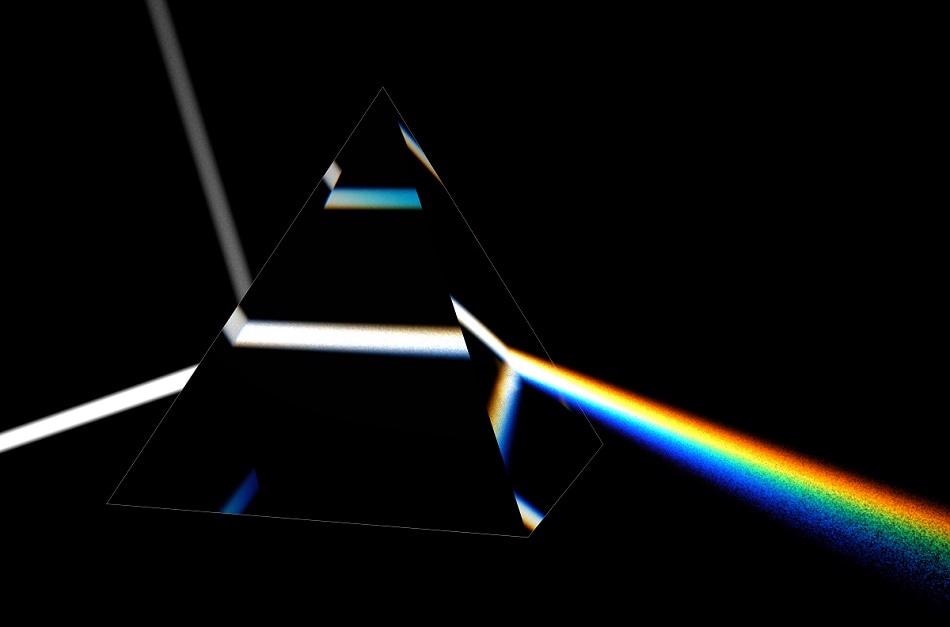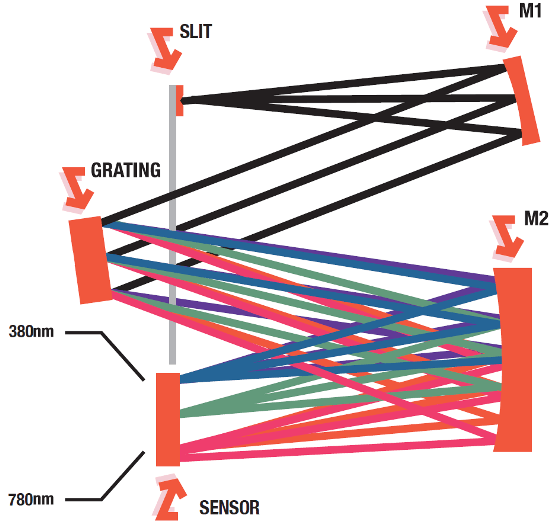Sponsored by AdmesyJan 31 2018
Spectroradiometers, also known as spectrometers, work on the principle of refracting light. Spectroradiometers allow measuring the light intensity per wavelength, which can then be visualized as a spectral distribution.

Image Credits: AlexLMX/shutterstock.com
Each type of light source has its own spectral distribution that show the proportions between individual wavelengths.
Using spectral distributions, qualitative aspects of light such as color and color rendering capabilities can be determined. Besides the visual spectrum covered by spectrophotometers, it is also possible to configure spectroradiometers to measure IR and UV light.

The illustration above shows the basic principle and components of a spectrophotometer’s optical bench as applied in Admesy’s Rhea spectroradiometer series for the VIS range. Image Credit: Admesy
Light's Journey Through the Spectrometer
Before entering the spectrometer light must first pass through an optical configuration, such as a lens, following which it enters the spectrometer through a slit. The amount of light entering the optical bench is regulated by the dimensions of slit, which in turn influences the optical resolution of a spectroradiometer.
This divergent incoming beam of light is reflected by a concave mirror (M1) into a collimating beam, which is directed towards a grating, which is where the dispersion of the light happens. A reflective grating is used by Admesy’s Rhea: upon reflecting on the grating, the collimated light beam is dispersed into all of its different wavelengths.
Multiple divergent beams are created when different wavelengths are reflected on the grating under different angles. The different separated wavelengths are then reflected and focused towards the detector by a second concave mirror (M2). A spectrometer’s optical bench is designed in such a way that specific wavelengths are focused on particular pixels of the sensor. To ensure this system works the entire device is wavelength calibrated by verifying wavelengths and assigning pixels to particular wavelengths: signals picked up by a pixel are linked to a specific wavelength.
A second calibration step is essential to make sure that not every pixel responds the same way to the true intensity of a wavelength. Hence, the correct proportions have to be determined for each pixel. This second calibration step is accomplished by calibrating against light sources such as a NIST traceable lamp. These light sources are supplied with datasheets on their spectral distribution in absolute values.
After matching the results from the spectrometer towards the known results of a standard light source, the device is fully calibrated and can be used for absolute and accurate measurements.
Once this calibration step is completed, the device can be called a spectroradiometer. Apart from the radiometric quantities, a spectroradiometer is capable of measuring colorimetric and photometric quantities very accurately if it covers the VIS range.
Spectroradiometers covering the 380-780 nm VIS range only are also called spectrophotometers. The spectral data is processed using software to derive precise values for the tri-stimulus values and other functions like the PAR. A major advantage of using a spectrophotometer to measure these values is the fact that measurement errors are lower compared to light meters or tri-stimulus colorimeters.
Although these values are more precisely displayed by a spectrophotometer, more time is typically required for a spectrophotometer to complete a measurement when compared to a colorimeter at a given luminance level.
A Brief History of Spectrometry
The history of spectrometers dates back to the 17th century when Sir Isaac Newton researched and demonstrated the composition of white light. He used a prism to demonstrate the possibility of dispersing incoming light into different wavelengths.
Each wavelength bends at a different angle upon passing through materials with different optical densities. Longer wavelengths, corresponding to red light, have the tendency to bend less than short wavelengths [blue light] in a prism.
A rainbow occurs based on this principle: when sunlight [which typically encompasses the complete visual spectrum] is dispersed in a raindrop, different wavelengths can be seen, starting from red, orange, yellow to green, blue and ending with violet in the sky.

 Download Admesy's Guide to Light for More Information
Download Admesy's Guide to Light for More Information

This information has been sourced, reviewed and adapted from materials provided by Admesy.
For more information on this source, please visit Admesy.